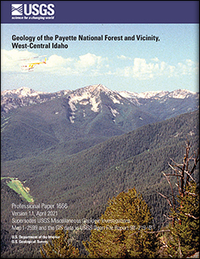Geology of the Payette National Forest and vicinity, west-central Idaho
Links
- Document: Report (13.9 MB pdf)
- Plates:
- Companion Files:
- Data Release: USGS data release
- Database: Geology of the Payette National Forest and vicinity, west-central Idaho (html) National Geologic Map Database Index Page
- Read Me: Read Me (3.0 kB txt)
- Version History: Version History (1.0 kB txt)
- Superseded Publications:
- Download citation as: RIS | Dublin Core
Abstract
Before the Late Cretaceous, the eastern and western parts of the geologically complex Payette National Forest, as divided by the Salmon River suture, had fundamentally different geologic histories. The eastern part is underlain by Mesoproterozoic to Cambrian(?) rocks of the Laurentian (Precambrian North American) continent. Thick Mesoproterozoic units, which are at least in part equivalent in age to the Belt Supergroup of northern Idaho and western Montana, under-went Mesoproterozoic metamorphic and deformational events, including intrusion of Mesoproterozoic plutons. During the Neoproterozoic to early Paleozoic, the western edge of Laurentia was rifted. This event included magmatism and resulted in deposition of rift-related Neoproterozoic to Lower Cambrian(?) volcanic and sedimentary rocks above Mesoproterozoic rocks. The western part of the forest is underlain by upper Paleozoic to lower Mesozoic island-arc volcanic and sedimentary rocks. These rocks comprise four recognized island-arc terranes that were amalgamated and intruded by intermediate-composition plutons, probably in the Late Jurassic and Early Cretaceous, and then sutured to Laurentia along the Salmon River suture in the Late Cretaceous.
The Salmon River suture formed as a right-lateral, transpressive fault. The metamorphic grade and structural complexity of the rocks increase toward the suture from both sides, and geochemical signatures in crosscutting plutonic rocks abruptly differ across the crustal boundary. Having been reactivated by younger structures, the Salmon River suture forms a north-trending topographic depression along Long Valley, through McCall, to the Goose Creek and French Creek drainages.
During the last stages of metamorphism and deformation related to the suture event, voluminous plutons of the Idaho batholith were intruded east of the suture. An older plutonic series is intermediate in composition and preserved as elongated and deformed bodies near the suture and as parts of roof pendants to younger intrusions to the east. A younger magma series consists of undeformed, marginally peraluminous plutons that formed east of the suture after accretion.
After suture-related compression, crustal extension resulted in voluminous volcanic and plutonic rocks of the Eocene Challis magmatic complex on the east side of the forest. Extension, from the Late Cretaceous to post-Miocene, uplifted the area of the Idaho batholith relative to the western part of the forest and formed dominant highlands along the Snake River. Extensional basins also formed such that, in the Miocene, the Columbia River Basalt Group and related basaltic lavas flowed over most of the lower elevations on the western side of the forest and redirected erosional debris into north-trending, fault-controlled drainages and young sedimentary basins.
Suggested Citation
Lund, K., 2004, Geology of the Payette National Forest and vicinity, west-central Idaho (ver. 1.1, April 2021): U.S. Geological Survey Professional Paper 1666–A, –B, 89 p., https://doi.org/10.3133/pp1666. [Supersedes USGS Miscellaneous Geologic Investigations Map I–2599 and the GIS data in USGS Open-File Report 98–219–B.]
ISSN: 2330-7102 (online)
Study Area
Table of Contents
- Abstract
- Introduction
- Metamorphic Rocks of Laurentia
- Rocks of Island-Arc Derivation
- Salmon River Suture Zone Complex
- Late Cretaceous Idaho Batholith
- Eocene Challis Magmatic Complex
- Weiser Embayment
- Quaternary Deposits
- Metamorphic History
- Structure
- References Cited
| Publication type | Report |
|---|---|
| Publication Subtype | USGS Numbered Series |
| Title | Geology of the Payette National Forest and vicinity, west-central Idaho |
| Series title | Professional Paper |
| Series number | 1666 |
| DOI | 10.3133/pp1666 |
| Edition | Version 1.1: April 13, 2021 |
| Year Published | 2021 |
| Language | English |
| Publisher | U.S. Geological Survey |
| Publisher location | Reston, VA |
| Contributing office(s) | Central Mineral and Environmental Resources Science Center |
| Description | Report: viii, 89 p.; 2 Plates: 38.00 x 54.50 inches and 57.00 x 42.00 inches; Read Me; Downloads Directory; Version History |
| Country | United States |
| State | Idaho |
| Other Geospatial | Payette National Forest |
| Online Only (Y/N) | Y |
| Google Analytic Metrics | Metrics page |


